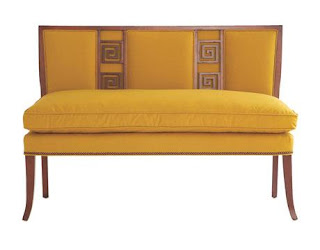I remember as a youngster my grandmother giving my sister the most wonderful gold bracelet. What struck me most about it was the amazing simplicity of the piece. A continuous band of gold with the Greek key design cut out. Unfortunately I haven’t got a photo, but you will get the general idea from the bracelet below.

The Greek Key design/motif is one of those timeless almost iconic representations of a classic design which has become an integral part of architecture through to fashion. Originally used by the Greeks as a border on many architectural friezes, it has been used through the ages without overkill and still remains elegant.


The design itself is stark and intensely graphic. (Maybe that is why I like it so much).


















 A fabulous piece of interior design work was the transformation of the interior of Elsfield Manor in England. It is a credit that his designs and final execution do not detract from the grand scale of the house. The only thing I am cringing over is the given loss of so many original fittings.
A fabulous piece of interior design work was the transformation of the interior of Elsfield Manor in England. It is a credit that his designs and final execution do not detract from the grand scale of the house. The only thing I am cringing over is the given loss of so many original fittings.


















